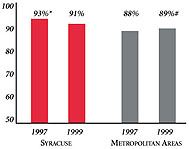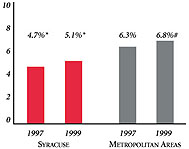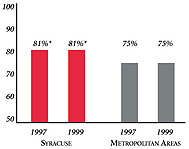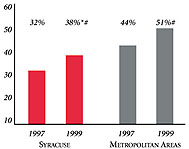Community Report No. 05
Winter 2001
Aaron Katz, Robert E. Hurley, Leslie A. Jackson, Timothy K. Lake, Ashley C. Short, James D. Reschovsky
| Syracuse Demographics |
| Syracuse |
Metropolitan areas above 200,000 population |
Population, July 1, 19991
732,920 |
| Population Change, 1990-19992
|
| -1.3% |
8.6% |
| Median Income3 |
| $24,619 |
$27,843 |
| Persons Living in Poverty3 |
| 14% |
14% |
| Persons Age 65 or Older3 |
| 14% |
11% |
Sources:
1. US Bureau of Census, 1999 Community Population Estimates
2. US Bureau of Census, 1990 & 1999 Community Population Estimates
3. Community Tracking Study Household Survey, 1998-1999 |
| Health System Characteristics |
| Syracuse |
Metropolitan areas above 200,000 population |
| Staffed Hospital Beds per 1,000 Population1
|
| 2.9 |
2.8 |
| Physicians per 1,000 Population2
|
| 2.4 |
2.3 |
| HMO Penetration, 19973 |
| 19% |
32% |
| HMO Penetration, 19994 |
| 21% |
36% |
Sources:
1. American Hospital Association, 1998
2. Area Resource File, 1998 (includes nonfederal, patient care physicians,
except radiologists, pathologists and anesthesiologists)
3. InterStudy Competitive Edge 8.1
4. InterStudy Competitive Edge 10.1 |





